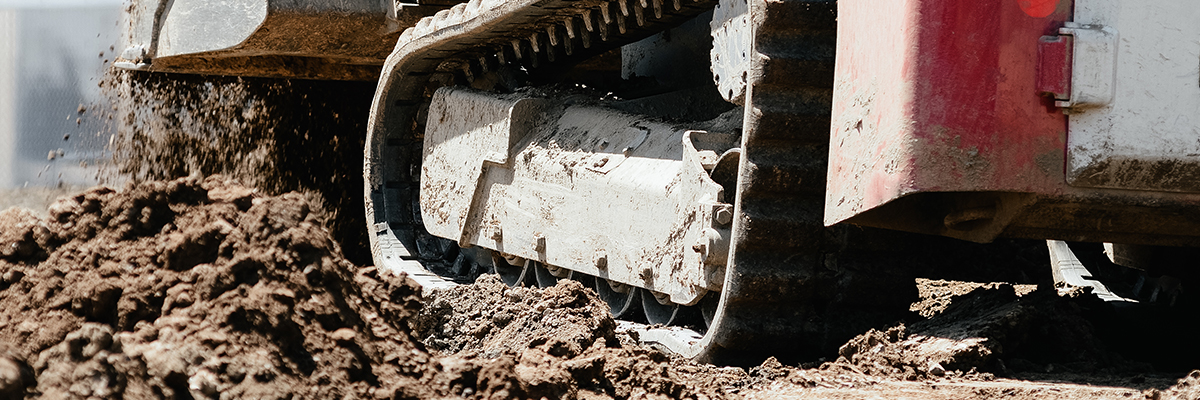How to replace rubber tracks in 10 simple steps

To minimise the standstill of a mini-excavator or compact track loader, it’s crucial to regularly check its tracks for telltale wear signs. In that way, you’ll know when to order new ones. Once the tracks get delivered to your doorstep, you can replace them yourself. But make sure the installation gets carried out correctly! Otherwise, you risk damage to the machine. Follow these 10 steps for a flawless installation of rubber tracks.
Install new rubber tracks in 10 steps
Step 1: Be well-prepared
Everything depends on good preparation. Before you start, make sure you have plenty of workspace, allowing you to manoeuvre around the mini-excavator or compact track loader. So move away any clutter and obstacles. Also position the machine on a flat surface free of debris, dirt and dust.
Ideally, there’s a colleague close by to help during the installation. Both of you should wear adequate personal protective equipment, including safety boots, safety glasses, gloves, ear protection and high visibility vests. Additionally, next to the replacement parts, you should have the following tools at hand
- The manual of the machine;
- Sockets and a torch wrench;
- Blocks of wood;
- A metal bar;
- Grease – check the machine's manual to find out what type you need:
When available, it’s also a good idea to keep a forklift close by. After all, rubber tracks are quite heavy, even when being lifted by two people.
Step 2: Lift the machine
Depending on the type of machine, there are various ways to lift it. When you’re working on a mini-excavator, lifting is easier when the machine has a blade. Lower the blade until the front of the tracks is off the ground. Then, turn the arm towards the back and push down until the tracks are in the air. To lift a mini-excavator without a blade, turn the arm to the side of the machine and push down until the track is raised. Of course, this means you can only replace one track at a time.
To lift a compact track loader, you need to position some blocks of wood firmly underneath the back of the machine. Tilt the bucket downwards and push down until the tracks are completely off the ground.
Step 3: Empty the grease cylinder
The grease cylinder keeps the track under tension, emptying it reduces that tension. Access the grease cylinder via the inspection hatch on the undercarriage. Typically, the idler will automatically move into the undercarriage as the grease is squeezed out.
But a small earth-mover with many working hours is generally dirty, so the idler might be stuck. In that case, place a wooden block between the track and the sprocket. Ask your colleague to start the machine and slowly move the track backwards. The piece of wood will turn with the sprocket, pulling the idler into the undercarriage.
Step 4: Remove the old track
Once the idler has been pulled inside the undercarriage of the mini-excavator, the track can easily be removed. First, lift the track of the idler. To remove the track from the sprocket, it’s best to slightly tilt the track. Once the track is loose from both the idler and sprocket, move it out of the way with a forklift.
With a compact track loader, this process differs. Even with an empty grease cylinder, the track is still secured by the sprocket and rear idler. Hence, you will need a metal bar to run the track off the sprocket and rear idler. Place the bar underneath the top of the track and ask your colleague to move the track backwards. This will loosen the track. Continue to guide the track off the sprocket and idler until it is completely off.
Step 5: Check the undercarriage parts
With the track removed, you can easily inspect the undercarriage parts. The machine’s manual will let you know how much wear is acceptable. If the idler and/or upper and lower rollers are too damaged, they should be replaced to avoid damage to the machine. Find those parts at TVH.
Step 6: Replace the sprocket
When installing new rubber tracks, you should also replace the sprockets. The sprocket and track work as a unit and wear out together. So if one is running on its last legs, the other is too. If you don’t replace the sprocket, the new track will wear out more and faster, and is even very likely to de-track! Loosen all the bolts of the sprocket. If you have difficulties removing it, a wooden block will help.
Now is also the perfect time to clean the contact surfaces on the drive motor. A build-up of rust and grease accumulates there, causing the sprocket to stick to the drive motor. When everything is clean, put the new sprocket into position and tighten it with a torque wrench.
Step 7: Install the new track
Before installing the track of a small-earth mover, always check if the track is positioned correctly. If the track has a V-shaped tread pattern, then that shape should point towards the front idler. In that way, the V-shape points towards the sprocket when the track travels under the machine. That orientation forces the dirt and mud outward from under the machine when in motion, and ensures that the machine has more traction.
With the new track in the correct position, place it on the sprocket of the mini-excavator. Have your colleague pull the other side over the idler. Then, use a metal bar to help you lift the hanging rubber track over the frame of the undercarriage. Make sure the teeth of the sprocket run between the links of the track. This can be achieved with some fitting and adjusting.
To equip a compact track loader with a new track, first lift the track on top of the sprocket. Put the track over the front idler and use a metal bar to force it over the back idler. Keep the metal bar at hand to work the track links onto the teeth of the sprocket. Switch between working on the back idler and on the sprocket to get the track in the correct position.
Step 8: Refill the grease cylinder
Once the track is in place, it has to be re-tensioned. Adding grease to the grease cylinder pushes out the idler and tightens the track. Consult the machine’s manual to find the required tension. Make sure the track isn’t too loose or too tight, since this increases the chance of wear. You can check the tension by measuring the distance between the bottom of the undercarriage and the inside of the track.
Step 9: Check the new track
When you’re done, move the track forwards and backwards to ensure the tracks and undercarriage parts have been properly installed. Afterwards, check the track's tension again and adjust if necessary. Finish the installation by tightly securing the inspection hatch.
Step 10: Replace the other rubber track if necessary
Ideally, you always replace both tracks and sprockets. This is definitely the case for compact track loaders, which usually work in motion and put more pressure on the tracks. A mismatched set of tracks will make fine finishing and grading almost impossible. With a mini-excavator, you can get away with only replacing one track and sprocket, since those commonly remain stationary when digging. However, it’s always better to replace both tracks at the same time.
When should you replace tracks?

The amount of time between the replacement of tracks heavily depends on how well the track is maintained. They can last anywhere between 400 and 2000 working hours, with an average lifespan from 1200 to 1600 working hours. Nevertheless, it’s always best to regularly check the tracks for typical wear signs.
Ordering new tracks and undercarriage parts
When tracks and undercarriage parts need to be replaced, technical support will come in handy to find the correct replacement parts. There is no international conformity for the measurement of tracks and every brand has its own system for undercarriage parts.
Therefore, the best way to find the correct tracks and undercarriage parts is through the machine details (make, model, etc.):
- Go to the MyPartsFinder search function on our online shop.
- Enter your machine’s details.
- Find the tracks and undercarriage parts you need!
You can also find an overview of our range of parts in our ‘Tracks & undercarriage parts’ catalogue.
Could you use some extra support to find the part(s) you need? Don’t hesitate to contact us, our skilled colleagues are happy to help.
About the authors
This blog post is brought to you by your construction equipment marketing team.
